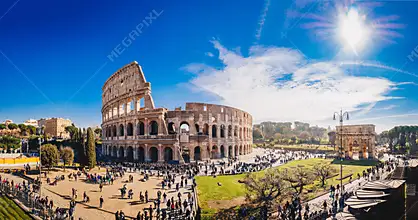Roman Colosseum Interior 4. The Coliseum Or Coliseum, Also Known As The Flavian Amphitheatre Is An Elliptical Amphitheater In The Center Of The City Of Rome, Italy. Built Of Concrete And Stone, It Was The Largest Amphitheater Of The Roman Empire, And Is Considered One Of The Greatest Works Of Roman Architecture And Engineering. It Is The Largest Amphitheater In The World. The Coliseum Could Hold, It Is Estimated, Between 50,000 And 80,000 Spectators, And Was Used For Gladiatorial Contests And Public Spectacles Such As Mock Sea Battles, Animal Hunts, Executions, Re-Enactments Of Famous Battles, And Dramas Based On Classical Mythology. The Building Ceased To Be Used For Entertainment In The Early Medieval Era. It Was Later Reused For Such Purposes As Housing, Workshops, Quarters For A Religious Order, A Fortress, A Quarry, And A Christian Shrine. Although In The 21St Century It Stays Partially Ruined Because Of Damage Caused By Devastating Earthquakes And Stone-Robbers, The Coliseum Is An Iconic Symbol Of Imperial Rome. It Is One Of Rome's Most Popular Tourist Attractions And Has Close Connections With The Roman Catholic Church, As Each Good Friday The Pope Leads A Torchlit Way Of The Cross Procession That Starts In The Area Around The Coliseum. In 2007 The Complex Was Included Among The New 7 Wonders Of The World
ID 969671699725 © Sunfire | Megapixl.com
CATEGORIES
EXCLUSIVE
Sharing is not just caring, it's also about giving credit - add this image to your page and give credit to the talented photographer who captured it.:
KEYWORDS
amphitheater amphitheatre animal architecture area attractions battles building built catholic center century christian church city classical coliseum colosseum complex concrete connections contests cross damage devastating dramas early earthquakes elliptical empire enactments engineering entertainment era executions exterior famous flavian fortress gladiatorial greatest housing hunts iconic imperial interior italy largest medieval mythology order pope popular procession public quarry quarters religious reused robbers roman rome ruined shrine spectacles spectators stone symbol torchlit tourist used wonders workshops world



































































